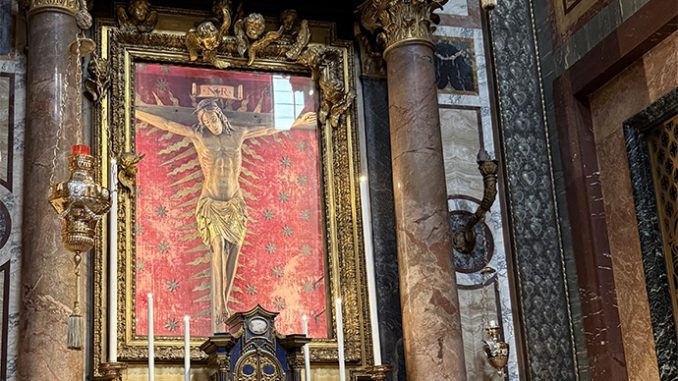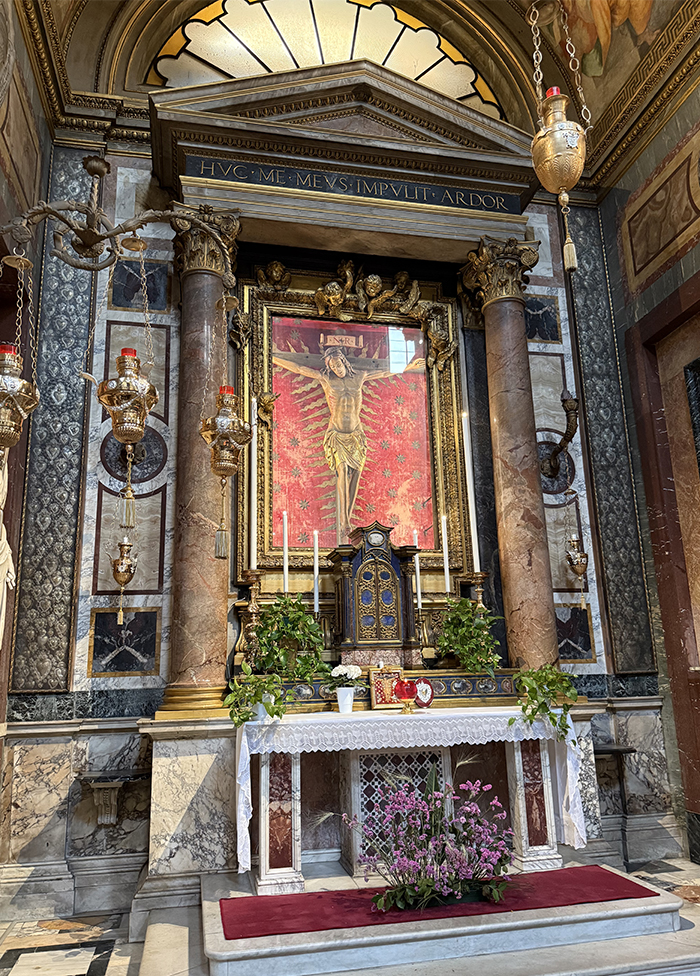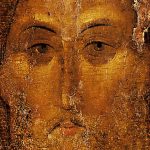
The paradox at the heart of Christianity is the Cross. Through Christ’s sacrifice, this instrument of death has become the source of lasting life. Christ hung upon the Cross not just as a “living victim” (CCC 1992), but as a victor. By his death, he destroyed death so that all who live and believe in him, even though they die, shall rise to live forever (Jn. 11:25).
Death, however, still plagues our earthly existence. As St. Paul teaches, it is the last enemy still to be defeated. (1 Cor. 15:26). The definitive defeat of death will come at the end of the age on the Day of Resurrection when Christ returns in glory. Until then, death still comes, and when it does for those we love, it is only natural to mourn, and when it comes for ourselves, it is only natural to fear. In the face of death, it is easy to succumb to these emotions and lose hope in God’s love and the power of his life-giving Cross.
At the Church of San Marcello al Corso in Rome, there is a representation of Christ on the Cross that has long been revered as miraculous. When the people of Rome were afraid in the face of death at the outbreak of the plague, they turned to it in hope.
On this Feast of the Exultation of the Holy Cross, it is worth recalling the prodigies of God’s loving mercy wrought through the miraculous crucifix of San Marcello so our own hope in the face of death might be strengthened.
The Via del Corso is the main street in the historical center of Rome. It runs north to south from the Piazza del Popolo to the Piazza Venezia at the base of the Capitoline Hill. In the days of the ancient empire, it was known as the Via Lata, “Broad Way,” as it was wider than most of the narrow streets that surrounded it, which are more like alleyways. The prestige of this road was reflected in the grand monuments of the empire that stood along it, like Augustus’ Ara Pacis, “Altar of Peace,” and Marcus Aurelius’ column erected in honor of his victories during the Barbarian Wars. From the 15th century, it became a fashionable street for new churches and palaces of the nobility. Around this time, the street served as the racetrack during an annual running of riderless horses called the corsa dei barberi, which is why it is known as the Corso today.
In 1659, Pope Alexander VII’s family, the Chigi, purchased and rebuilt a palace in the piazza of Marcus Aurelius’ column, which serves today as the official residence of the prime minister of Italy. The Chigi Palace is about halfway along the Corso. A little further south, towards the Piazza Venezia, is where the Church of San Marcello is found.
According to the Liber Pontificalis, a collection of biographies of the popes through the 15th century, the church is built over the catabulum, or stables of the empire’s central post office, where horses would be dispatched daily to carry letters throughout the empire. It was here that Pope Saint Marcellus I (who reigned from 308 to 309) died a martyr after being condemned to penal servitude in the stables by the emperor Maxentius.
The first historical mention of a church on the site in honor of the martyred pope was in 418. Over the centuries, it has undergone many reconstructions, and today, even by Rome’s high standards, it stands as a particularly beautiful baroque structure. Its unique curving facade is an addition made by Carlo Fontana in 1686. Its elegance matches the character of today’s Via del Corso, which is lined with high-end boutiques.
The remains of Pope Marcellus are interred within the high altar. What draws most pilgrims to this church, however, is the miraculous crucifix kept above one of its many side altars. It is located in the Chapel of the Crucifix, which is the fourth chapel found on the church’s right side.
Scholars say the crucifix is of the Sienese school and dates to the 14th century. It is so realistic in its imagery of the Lord’s agonizing death that a widespread and disturbing legend has circulated about its origins. The sculptor is alleged to have kidnapped and slowly killed a peasant, using his agony to accurately depict that of the Lord’s upon the cross.
When the previous iteration of the Church of San Marcello burnt to the ground on May 23, 1519, the only image to survive unscathed was this crucifix. It was considered miraculous as a result and became highly revered among the Roman people in its place in the rebuilt church.
Since the global outbreak of the coronavirus in 2019, our modern world has become familiar with the suffering that pandemics bring. Even still, what the world endured during that terrible episode pales in comparison to the most fatal pandemic in history, the bubonic plague that peaked in Europe from 1347 to 1351. Europe’s population was reduced by a staggering half, and 75 to 200 million people were killed overall, throughout Eurasia and North Africa. Although the plague died out in most places, it became a continually recurring endemic over the course of the following centuries.
When a recurrence of the plague struck Rome in 1522, so did the fear of death. But as St. Paul says, disciples of the Lord Jesus do not encounter death as those without hope (1 Thess. 4:13). Society at the time was firmly rooted in the Faith, and the Roman people did not lose hope in God’s love for them. If they perished of sickness, they believed they would rise with him. But they also believed in miracles. Just as Jesus cured the sick and raised the dead to life during his earthly ministry in response to sincere expressions of faith, they believed he might spare them the ravages of the plague if they, too, boldly expressed their hope and trust in him.
The Basilica’s titular cardinal, Raimondo de Vico, along with the Servite Fathers, who had custody of San Marcello since 1368, arranged to have the miraculous crucifix carried in a penitential procession to pray for an end to the plague. Much like public worship was forbidden during the coronavirus pandemic of recent memory, the civil authorities of the time attempted to prevent the procession, fearing a spread of the contagion. They were unable to constrain the people’s devotion, however, and the procession began with large numbers accompanying the crucifix.
Flagellating themselves while processing, many cried out, “Mercy, Holy Crucifix!” The Roman faithful humbly recognized that it was for the remission of our sins that Christ was crucified and God’s mercy is sought not out of confidence in our own merits, but by those of his Son’s passion.
The procession was intended to go from San Marcello to St. Peter’s Basilica, which is about a mile and a half away. What could be accomplished easily in one afternoon took 16 days. The procession lasted from August 4th to 20th. It took so long because, as the plague miraculously receded in each neighborhood, the crucifix was brought through, and the people there would insist it remain among them for as long as possible.
By the time the crucifix reached St. Peter’s, the entire city began to notice the dissipation of the plague. By this miracle, the city of Rome was able to see evidence for the ultimate truth of the Christian faith—the love of Christ crucified is stronger than death (cf. Song of Sol. 8:6).
In thanksgiving, Cardinal de Vico established a confraternity devoted to the miraculous crucifix of San Marcello, which was one of Rome’s most prominent and influential for generations. Devotion to the crucifix has continued unabated to today. It is still carried in procession to St. Peter’s on special occasions, such as the opening of the Second Vatican Council (1962-1965) and on the “Day of Forgiveness” presided over by Pope Saint John Paul II during the Great Jubilee of 2000.
The last time it returned to the Vatican was March 27, 2020, during the coronavirus pandemic, when Pope Francis chose to have it present for a prayer vigil in St. Peter’s Square held for the pandemic’s end.
In every Catholic church throughout the world, the Cross is to be found at the center above the altar of sacrifice. It is there as a sign announcing God’s love to all who enter. Above the miraculous crucifix of San Marcello is an inscription etched in marble that reads: HUC ME MEVS IMPVLIT ARDOR (“To this my zeal has impelled me”). Yes, Christ’s zeal, the ardor of his love for our fallen humanity, impelled him to become “obedient to the point of death, even death on a cross” (Phil. 2:8). As the Roman people faced the prospect of their own death with the arrival of the plague, they displayed an unwavering hope in the power of the Cross.
May the story of the miraculous crucifix of San Marcello stir up within us the same hope. Christ, through his Cross, has broken the bonds of death.

If you value the news and views Catholic World Report provides, please consider donating to support our efforts. Your contribution will help us continue to make CWR available to all readers worldwide for free, without a subscription. Thank you for your generosity!
Click here for more information on donating to CWR. Click here to sign up for our newsletter.















